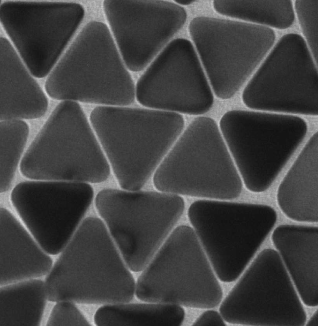All About Gold Nanotriangles
Definition, Properties and Applications
Gold nanotriangles are a unique class of nanoparticles that have garnered significant attention due to their remarkable properties and diverse applications. These nanotriangles are synthesized through various methods, including the use of plant extracts (Chandran et al., 2006), microwave-assisted polyol synthesis (Yu et al., 2015), and protein-mediated autoreduction of gold salts (Basu et al., 2008). The synthesis of gold nanotriangles has been studied extensively, with a focus on size control, large-scale self-assembly, and performance in surface-enhanced Raman scattering (Scarabelli et al., 2014). The optical properties of these nanotriangles, particularly their near-infrared (NIR) absorption, make them suitable for applications such as hyperthermia of cancer cells and infrared-absorbing optical coatings (Shankar et al., 2005; Rai et al., 2005). Additionally, gold nanotriangles exhibit interesting nanoplasmonic features, making them valuable in fields such as photonics, optical coating, optoelectronics, magnetism, catalysis, and chemical sensing (Gaware et al., 2012).
The unique shape and properties of gold nanotriangles have led to their application in various fields. For instance, they have been utilized in localized surface plasmon resonance (LSPR) biosensing for the detection of DNA hybridization events at room temperature (Soares et al., 2014). Furthermore, gold nanotriangles have been employed in the ultra-low level optical detection of mercuric ions, demonstrating their potential for sensitive and selective ion detection (Singh et al., 2012). The use of biologically synthesized gold nanotriangles in photothermal therapy and biosensing has also been explored, highlighting their effectiveness in these applications (Yu et al., 2015). Moreover, the potential application of gold nanotriangles in hyperthermia of cancer cells and targeted drug delivery has been investigated, indicating their versatility in biomedical applications ("Invited abstracts", 2010).
The properties of gold nanotriangles, such as their localized surface plasmon resonance and unique optical near-fields, have been extensively studied, providing insights into their potential for various applications (Kuwahara et al., 2020; Boneberg et al., 2007). Additionally, the controlled growth and self-assembly of gold nanotriangles have been investigated, offering opportunities for the development of advanced nanomaterials with tailored properties (Liebig et al., 2018; Liebig et al., 2016). The anisotropic nature of these nanoparticles, along with their ability to facilitate welding and exhibit electromagnetically seamless bonding, further expands their potential applications in multicolor sensing and light-harvesting (Kuwahara et al., 2020).
In summary, gold nanotriangles are a fascinating class of nanoparticles with unique properties that make them valuable in a wide range of applications, including biomedical, sensing, and optical fields. Their synthesis, optical properties, and potential applications have been extensively studied, providing a solid foundation for further exploration and utilization in various technological and scientific domains.
Go here for Nanopartz Gold Nanotriangles
References:
(2010). Invited abstracts. Medicinal Chemistry Research, 19(S1), 3-41. https://doi.org/10.1007/s00044-010-9296-3
Basu, N., Bhattacharya, R., & Mukherjee, P. (2008). Protein-mediated autoreduction of gold salts to gold nanoparticles. Biomedical Materials, 3(3), 034105. https://doi.org/10.1088/1748-6041/3/3/034105
Boneberg, J., König-Birk, J., Münzer, H., Leiderer, P., Shuford, K., & Schatz, G. (2007). Optical near-fields of triangular nanostructures. Applied Physics A, 89(2), 299-303. https://doi.org/10.1007/s00339-007-4138-y
Chandran, S., Chaudhary, M., Pasricha, R., Ahmad, A., & Sastry, M. (2006). Synthesis of gold nanotriangles and silver nanoparticles using aloe vera plant extract. Biotechnology Progress, 22(2), 577-583. https://doi.org/10.1021/bp0501423
Gaware, U., Kamble, V., & Ankamwar, B. (2012). Ecofriendly synthesis of anisotropic gold nanoparticles: a potential candidate of sers studies. International Journal of Electrochemistry, 2012, 1-6. https://doi.org/10.1155/2012/276246
Kuwahara, S., Narita, Y., Mizuno, L., Kurotsu, H., Yoshino, H., & Kuwahara, M. (2020). Localized surface plasmon resonance-induced welding of gold nanotriangles and the local plasmonic properties for multicolor sensing and light-harvesting applications. Acs Applied Nano Materials, 3(6), 5172-5177. https://doi.org/10.1021/acsanm.0c00608
Liebig, F., Sarhan, R., Prietzel, C., Thünemann, A., Bargheer, M., & Koetz, J. (2018). Undulated gold nanoplatelet superstructures: in situ growth of hemispherical gold nanoparticles onto the surface of gold nanotriangles. Langmuir, 34(15), 4584-4594. https://doi.org/10.1021/acs.langmuir.7b02898
Liebig, F., Thünemann, A., & Koetz, J. (2016). Ostwald ripening growth mechanism of gold nanotriangles in vesicular template phases. Langmuir, 32(42), 10928-10935. https://doi.org/10.1021/acs.langmuir.6b02662
Rai, A., Singh, A., Ahmad, a., & Sastry, M. (2005). Role of halide ions and temperature on the morphology of biologically synthesized gold nanotriangles. Langmuir, 22(2), 736-741. https://doi.org/10.1021/la052055q
Scarabelli, L., Coronado‐Puchau, M., Giner‐Casares, J., Langer, J., & Liz‐Marzán, L. (2014). Monodisperse gold nanotriangles: size control, large-scale self-assembly, and performance in surface-enhanced raman scattering. Acs Nano, 8(6), 5833-5842. https://doi.org/10.1021/nn500727w
Shankar, S., Rai, A., Ahmad, a., & Sastry, M. (2005). Controlling the optical properties of lemongrass extract synthesized gold nanotriangles and potential application in infrared-absorbing optical coatings. Chemistry of Materials, 17(3), 566-572. https://doi.org/10.1021/cm048292g
Singh, A., Pasricha, R., & Sastry, M. (2012). Ultra-low level optical detection of mercuric ions using biogenic gold nanotriangles. The Analyst, 137(13), 3083. https://doi.org/10.1039/c2an35162e
Soares, L., Csáki, A., Jatschka, J., Fritzsche, W., Flores, O., Franco, R., … & Pereira, E. (2014). Localized surface plasmon resonance (lspr) biosensing using gold nanotriangles: detection of dna hybridization events at room temperature. The Analyst, 139(19), 4964-4973. https://doi.org/10.1039/c4an00810c Yu,
S., Hachtel, J., Chisholm, M., Pantelides, S., Laromaine, A., & Roig, A. (2015). Magnetic gold nanotriangles by microwave-assisted polyol synthesis. Nanoscale, 7(33), 14039-14046. https://doi.org/10.1039/c5nr03113c

